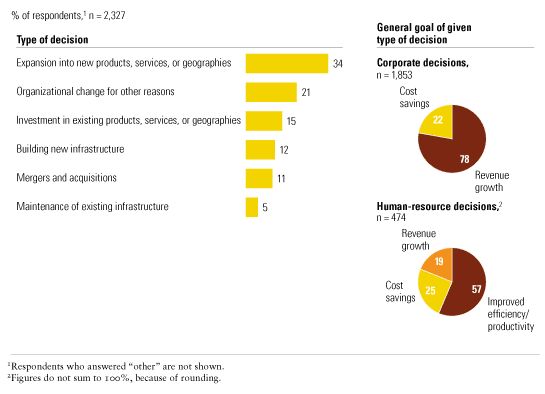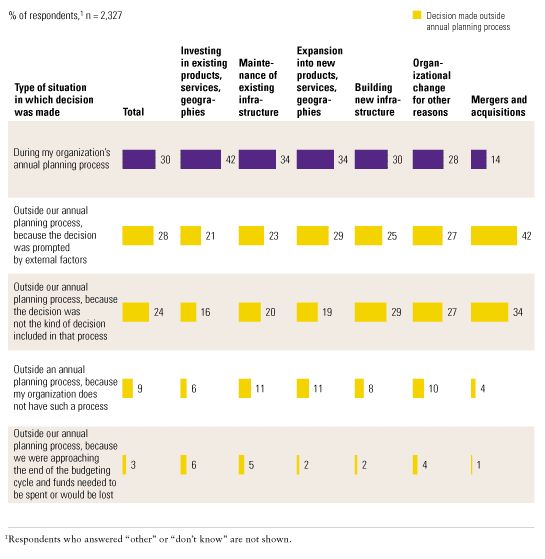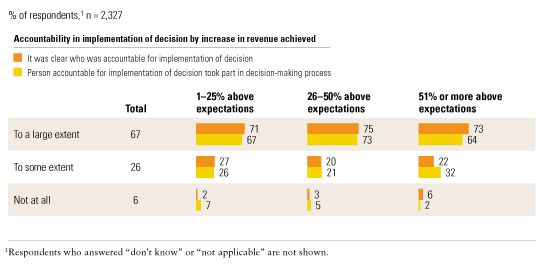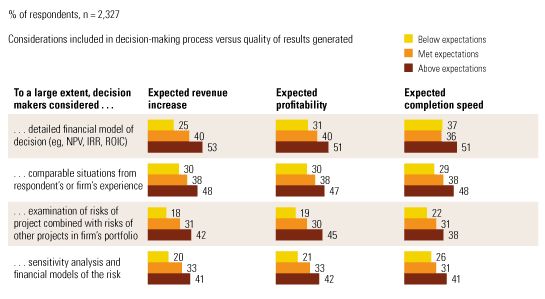Do strong decision-making processes lead to good decisions? This McKinsey survey highlights several process steps that are strongly associated with good financial and operational outcomes. In the survey, we asked executives from around the world about a specific capital or human-resources decision their companies made in the course of normal business. We learned who was involved, what drove the decisions, how deep the analysis was, how unfettered the discussions, and how and where politics were involved. Respondents also described the financial and operational outcomes of the decisions.1
The results highlight the hard business benefits—such as increased profits and rapid implementation—of several decision-making disciplines. These disciplines include ensuring that people with the right skills and experience are included in decision making, making decisions based on transparent criteria and a robust fact base, and ensuring that the person who will be responsible for implementing a decision is involved in making that decision. Finally, although corporate politics sometimes seems to undermine strong decision making, some types of consensus-building and alliances apparently can help create good outcomes.
Describing the decisions
The survey covered the gamut of typical corporate decisions, from expanding into new products or services to maintaining infrastructure. More than three-quarters of investments were aimed at revenue growth, and among decisions related to human resources, the majority aimed to improve efficiency or productivity (Exhibit 1).
A majority of decisions were undertaken at the behest of the CEO or the executive committee, with only a minority (23 percent) driven by some sort of immediate threat. More decisions were made outside an annual planning process than within one (Exhibit 2). And nearly two-thirds of respondents say they expected their decision to pay off within two years of implementation. Operations executives had significant influence on only about a third of the most financially unsuccessful decisions, reinforcing findings from other surveys that companies frequently overlook execution when making decisions.2
Goals of strategic decision making

Most decisions outside an annual planning process

Overall, outcomes for these decisions were good. Among decisions for which the outcome was known, about two-thirds met or exceeded executives’ expectations for revenue growth and cost savings.3 Furthermore, strong majorities of respondents say the results of their initiatives met their expectations for speed, implementation cost, and gains in market share or efficiency.
What goes into a good decision
For starters, the survey emphasizes that good decision making involves avoiding some basic mistakes. Decisions initiated and approved by the same person generate the worst financial results—indicating the value of good discussion. And decisions made at companies without any strategic planning process are twice as likely to have generated extremely poor results as extremely good ones—more than a fifth of them generated revenue 75 percent or more below expectations. This may indicate an overall lack of rigor at these companies.
Furthermore, this survey highlights several elements of decision-making processes that are associated with good financial and operational outcomes, whether the goal is revenue growth or cost savings. One relatively straightforward finding is of strong relationships linking financial success, clarity about who is responsible for implementation, and the involvement of that individual in the decision-making process (Exhibit 3). Other important findings concern the types of analysis, discussion, and corporate politics that are associated with successful decision making.
Accountability linked to financial success

Analytic tools in successful decisions

Analysis
We asked about 11 aspects of analysis.4 Four are associated with financial success, speed of project completion, cost to implement, and improved efficiency or productivity (Exhibit 4):
Performing sensitivity analysis and creating financial-risk models
Including comparable situations from one’s own or the firm’s experience
Examining the risks of this project combined with the risks of other projects in the firm’s portfolio
Creating a detailed financial model of the decision
The survey also indicates that including analogous situations from outside of the organization improves some outcomes, notably expected profitability and revenue growth.
Discussion methods of successful decisions

Discussion
Respondents also describe the discussions surrounding their decisions. Of the eight potential discussion types we asked about,5 three are associated with financial success and with completion of the project in less time than expected (Exhibit 5):
Encouragement of participation on the basis of individuals’ skills or experiences
Reliance upon transparent approval criteria for the decision
Discussion of this decision as part of the firm’s whole portfolio of decisions
Politics
Corporate politics has a bad name, but respondents suggest that the effect of politics depends on the nature of the tactics used. When executives involved in a decision were primarily concerned with its effect on their business unit rather than the overall organization, for example, financial results and all other measures of success were much likelier to fall far below expectations. Simply put, a silo mind-set hurts performance. In addition, slow project completion times are associated with selective information reporting.
However, the survey results suggest some types of informal alliance-building and horse-trading among executives may help companies make good decisions. We asked about six ways that politics can affect decisions.6 Better-than-expected completion speed is associated with executives forming alliances to craft consensus for action across business units and with executives making exchanges across alliances to build support for different projects.
Finally, a word about CEO involvement: Respondents say CEOs tended to have a large role in instigating both the most and the least successful decisions. Perhaps this indicates CEOs are more likely than other executives to place—or be able to secure approval of—risky bets with big upsides and downsides. This result also suggests that thorough examination and devil’s advocacy will be particularly valuable when CEOs champion pet projects.
Looking ahead
Unlike the external risks that accompany most strategic initiatives, the analysis of a project, its discussion, and the management of the internal politics lie entirely within the control of the top leadership team. Companies not using the best practices identified here should be able to improve their decisions simply by following these guidelines:
Pay particular attention to the risks of the project, examined through a detailed financial model, sensitivity analysis, and the relationship of those risks to the risks of other projects in the firm’s portfolio. Learning from past comparable situations also is beneficial.
Ensure that participants in the discussion about any decision are included on the basis of skills and experience, that decision criteria are transparent, and that the decision is discussed in relation to the organization’s other strategic decisions.
Put organizational goals ahead of business unit goals, and encourage efforts to build consensus across business units.
